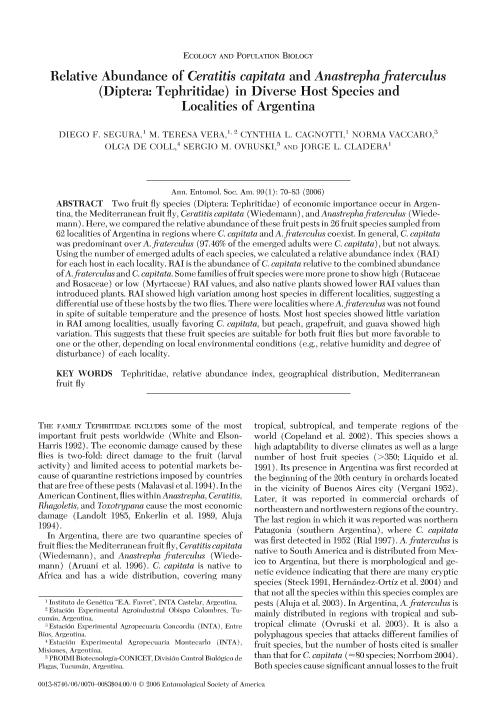Mostrar el registro sencillo del ítem
dc.contributor.author
Segura, Diego Fernando

dc.contributor.author
Vera, María Teresa

dc.contributor.author
Cagnotti, Cynthia Lorena

dc.contributor.author
Vaccaro, Norma
dc.contributor.author
De Coll, Olga
dc.contributor.author
Ovruski Alderete, Sergio Marcelo

dc.contributor.author
Cladera, Jorge Luis

dc.date.available
2018-04-25T18:49:17Z
dc.date.issued
2006-01
dc.identifier.citation
Segura, Diego Fernando; Vera, María Teresa; Cagnotti, Cynthia Lorena; Vaccaro, Norma; De Coll, Olga; et al.; Relative Abundance of Ceratitis capitata and Anastrepha fraterculus (Diptera: Tephritidae) in Diverse Host Species and Localities of Argentina; Entomological Society of America; Annals of the Entomologycal Society of America; 99; 1; 1-2006; 70-83
dc.identifier.issn
0013-8746
dc.identifier.uri
http://hdl.handle.net/11336/43487
dc.description.abstract
Two fruit fly species (Diptera: Tephritidae) of economic importance occur in Argentina, the Mediterranean fruit fly, Ceratitis capitata (Wiedemann), and Anastrepha fraterculus (Wiedemann). Here, we compared the relative abundance of these fruit pests in 26 fruit species sampled from 62 localities of Argentina in regions where C. capitata and A. fraterculus coexist. In general, C. capitata was predominant over A. fraterculus (97.46% of the emerged adults were C. capitata), but not always. Using the number of emerged adults of each species, we calculated a relative abundance index (RAI) for each host in each locality. RAI is the abundance of C. capitata relative to the combined abundance of A. fraterculus and C. capitata. Some families of fruit species were more prone to show high (Rutaceae and Rosaceae) or low (Myrtaceae) RAI values, and also native plants showed lower RAI values than introduced plants. RAI showed high variation among host species in different localities, suggesting a differential use of these hosts by the two flies. There were localities where A. fraterculus was not found in spite of suitable temperature and the presence of hosts. Most host species showed little variation in RAI among localities, usually favoring C. capitata, but peach, grapefruit, and guava showed high variation. This suggests that these fruit species are suitable for both fruit flies but more favorable to one or the other, depending on local environmental conditions (e.g., relative humidity and degree of disturbance) of each locality.
dc.format
application/pdf
dc.language.iso
eng
dc.publisher
Entomological Society of America

dc.rights
info:eu-repo/semantics/openAccess
dc.rights.uri
https://creativecommons.org/licenses/by-nc-sa/2.5/ar/
dc.subject
Tephritidae
dc.subject
Relative Abundance Index
dc.subject
Geographical Distribution
dc.subject
Mediterranean Fruit Fly
dc.subject.classification
Otras Ciencias Biológicas

dc.subject.classification
Ciencias Biológicas

dc.subject.classification
CIENCIAS NATURALES Y EXACTAS

dc.title
Relative Abundance of Ceratitis capitata and Anastrepha fraterculus (Diptera: Tephritidae) in Diverse Host Species and Localities of Argentina
dc.type
info:eu-repo/semantics/article
dc.type
info:ar-repo/semantics/artículo
dc.type
info:eu-repo/semantics/publishedVersion
dc.date.updated
2018-04-18T17:52:30Z
dc.journal.volume
99
dc.journal.number
1
dc.journal.pagination
70-83
dc.journal.pais
Estados Unidos

dc.journal.ciudad
Lanham
dc.description.fil
Fil: Segura, Diego Fernando. Consejo Nacional de Investigaciones Científicas y Técnicas; Argentina. Instituto Nacional de Tecnología Agropecuaria. Centro de Investigación en Ciencias Veterinarias y Agronómicas. Instituto de Genética; Argentina
dc.description.fil
Fil: Vera, María Teresa. Consejo Nacional de Investigaciones Científicas y Técnicas; Argentina. Instituto Nacional de Tecnología Agropecuaria. Centro de Investigación en Ciencias Veterinarias y Agronómicas. Instituto de Genética; Argentina. Gobierno de Tucumán. Ministerio de Desarrollo Productivo. Estación Experimental Agroindustrial Obispo Colombres; Argentina
dc.description.fil
Fil: Cagnotti, Cynthia Lorena. Instituto Nacional de Tecnología Agropecuaria. Centro de Investigación en Ciencias Veterinarias y Agronómicas. Instituto de Genética; Argentina. Consejo Nacional de Investigaciones Científicas y Técnicas; Argentina
dc.description.fil
Fil: Vaccaro, Norma. Estación Experimental Agropecuaria Concordia; Argentina
dc.description.fil
Fil: De Coll, Olga. Instituto Nacional de Tecnología Agropecuaria. Centro Regional Misiones. Estación Experimental Agropecuaria Montecarlo; Argentina
dc.description.fil
Fil: Ovruski Alderete, Sergio Marcelo. Consejo Nacional de Investigaciones Científicas y Técnicas. Centro Científico Tecnológico Conicet - Tucumán. Planta Piloto de Procesos Industriales Microbiológicos; Argentina
dc.description.fil
Fil: Cladera, Jorge Luis. Instituto Nacional de Tecnología Agropecuaria. Centro de Investigación en Ciencias Veterinarias y Agronómicas. Instituto de Genética; Argentina
dc.journal.title
Annals of the Entomologycal Society of America

dc.relation.alternativeid
info:eu-repo/semantics/altIdentifier/url/https://academic.oup.com/aesa/article/99/1/70/47479
dc.relation.alternativeid
info:eu-repo/semantics/altIdentifier/doi/http://dx.doi.org/10.1603/0013-8746(2006)099[0070:RAOCCA]2.0.CO;2
Archivos asociados
